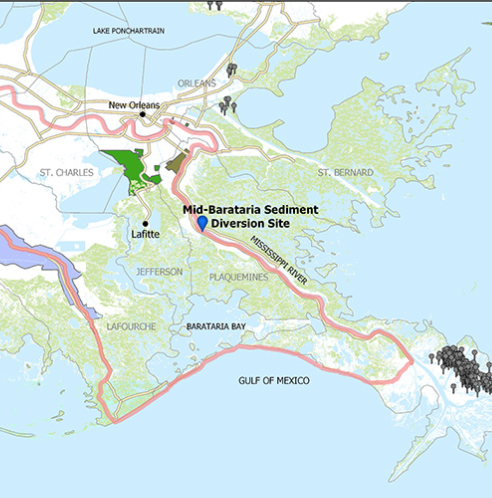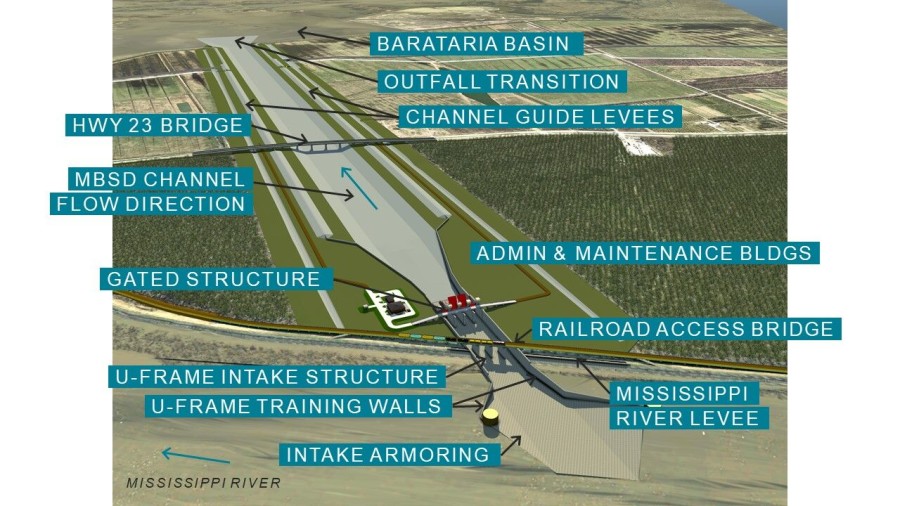A Corps of Engineers environmental impact statement for the planned $2 billion Mid-Barataria Sediment Diversion project acknowledges it will drastically alter the south Louisiana shrimp and oyster fisheries.
“Moderate to major, adverse, permanent direct and indirect impacts are anticipated on shrimp fisheries in the Project area due to expected negligible to minor, permanent, beneficial impacts on white shrimp, and major, permanent, adverse impacts on brown shrimp abundance,” states an executive summary of the report issued March 5.
While it may be possible for fishermen to target other species, that “would require additional investment by individual fishers, which may or may not be financially feasible,” the report adds. “Declines in shrimp abundance may also exacerbate trends in the aging workforce to leave the industry.”
Projected to be built over five years, the diversion plan by the state Coastal Protection and Restoration Authority could be the first of similar projects for bringing new sediment into south Louisiana’s steadily eroding coastal lands and marshes, instead of the sediment washing from the river mouth into the Gulf of Mexico.
Project supporters say it’s essential to maintaining the state’s land mass and hurricane protection for New Orleans and other communities. Critics ¬– including much of the state’s seafood industry – want to see alternative that won’t dramatically alter their livelihoods.
"All of us in the fisheries industry knew this all along," said George Ricks, president of the Save Louisiana Coalition, which has argued for dredging and other methods to move sediment instead of freshwater diversion. "The CPRA has always downplayed the effect on fisheries."
“The Mid-Barataria Sediment Diversion is the largest project of its kind ever undertaken in U.S. history, and represents an unparalleled, innovative coastal restoration effort unlike anything else in the world,” said Chip Kline, the chairman of the Louisiana Coastal Protection and Restoration Authority in a statement after the EIS release.
“This project will build and sustain thousands of acres of wetlands by reconnecting the Mississippi River to our wetlands and restoring the natural processes that built the very land we stand on today. This project also means added storm protection for our communities, a functional estuary that will support fish and wildlife into the future, and a significant economic stimulus that will add thousands of additional jobs to the region."
Overall, the Barataria Basin has lost more than 276,000 acres of land since the 1930s, a process accelerated by damage from the 2010 Deepwater Horizon oil spill, according to NOAA. It and other agencies plan to spend up to $2 billion on restoration, and series of public comment and virtual hearing events is being held through May 4.
CPRA planners say the project would add more than 17,000 acres of land in the Barataria Basin over 30 years and reduce hurricane storm surge levels by a foot in communities north of the project location in Plaquemines Parish.

Project boosters say building the new land can generate 12,400 jobs. But it will come at a long-term cost according to critics, and the Corps paper bears out their fears.
Freshwater species could thrive amid the redirected river flow but commercially valuable saltwater species would decline as would the Barataria Bay population of bottlenose dolphins, the report notes.
While rebuilding marshes may eventually increase habitat for shrimp, those later years “would not substantially alter the stated impacts on the shrimping industry in the Project area,” the Corps review predicts.
Louisiana fishermen landed $34.6 million of brown shrimp in 2019, "and 31 percent was from Barataria Bay, so right out of the gate (with diversion) you lose $11 million," said Ricks.
Likewise, “the eastern oyster fishery in the Project area is expected to experience major, permanent, adverse impacts under the proposed Project, although it is possible that areas near the barrier islands could be used as seed grounds and growing areas for adults when salinities are too low throughout the rest of the Barataria Basin,” the report says.
The report describes how the diversion could affect communities outside of modern levee systems, especially lower-income and minority populations in Myrtle Grove, Hermitage, Grand Bayou and Happy Jack.
“To a lesser extent, tidal flooding could increase in the Lafitte area, which includes multiple communities with varying levels of existing non-federal flood protection. In addition, disproportionately high and adverse impacts on low- income and minority populations could occur in some communities where reductions in abundance of oysters, brown shrimp, and certain finfish species are anticipated as a result of the Project,” the report says. “These impacts could occur to the extent that affected populations engage in or are heavily reliant on commercial and subsistence fishing for these species.”







